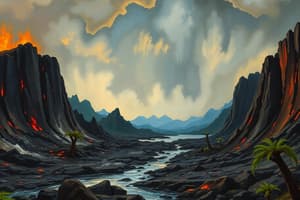Podcast
Questions and Answers
What is aa lava, and how is it distinguished from other types of lava?
What is aa lava, and how is it distinguished from other types of lava?
Aa lava is a viscous type of lava characterized by its rough, jagged surface, often making it difficult to walk on.
Describe the typical size and characteristics of a lava dome.
Describe the typical size and characteristics of a lava dome.
A lava dome is typically hundreds of meters thick and wide, formed from highly viscous lava.
What are dykes in volcanic geology, and how do they form?
What are dykes in volcanic geology, and how do they form?
Dykes are deep, tabular formations created when lava flows vertically towards the surface.
What process occurs when volcanic magma transforms into lava?
What process occurs when volcanic magma transforms into lava?
Explain the formation of pillow lavas and their unique characteristics.
Explain the formation of pillow lavas and their unique characteristics.
How does the silica content impact the viscosity of lava?
How does the silica content impact the viscosity of lava?
What types of fractures can occur during the cooling of lava, and what shapes do they form?
What types of fractures can occur during the cooling of lava, and what shapes do they form?
What are the three basic classes of lavas based on their silica content?
What are the three basic classes of lavas based on their silica content?
What is a cryptodome, and how does it form?
What is a cryptodome, and how does it form?
What are Pahoehoe lava flows, and what characteristic do they exhibit?
What are Pahoehoe lava flows, and what characteristic do they exhibit?
Flashcards
Lava definition
Lava definition
Molten rock that flows from a volcano, formed when magma loses its gases.
Lava viscosity
Lava viscosity
Lava's resistance to flow; influenced by silica content and crystal/mineral content.
Lava types: Acid
Lava types: Acid
Lava with high silica content; examples include Rhyolite and Dacite; more viscous.
Lava types: Basic
Lava types: Basic
Signup and view all the flashcards
Lava degassing
Lava degassing
Signup and view all the flashcards
Aa lava flow
Aa lava flow
Signup and view all the flashcards
Lava dome
Lava dome
Signup and view all the flashcards
Dykes
Dykes
Signup and view all the flashcards
Pillow lava
Pillow lava
Signup and view all the flashcards
Columnar basalt
Columnar basalt
Signup and view all the flashcards
Study Notes
Lava Properties and Formation
- Lava is magma that has lost its volatile components (gases) under pressure.
- The pressure drop outside the Earth's crust causes degassing. Gases like water vapor, CO2, CO, SO2, SO3, Cl2, and N2 are released.
- Lava temperature ranges from 800°C to 1200°C.
- Lava viscosity varies greatly, up to 100,000 times that of water, depending on composition.
- Viscosity influences flow distance and shape.
- Lava solidifies to form effusive igneous rocks.
Chemical Classification
- Lava is classified by silica content:
- Acid/Sialic: High silica (Rhyolite, Dacite)
- Intermediate: Medium silica (Phonolite, Andesite, Hawaiite)
- Ultrabasic: Low silica (Tephra, Basanite)
- Silica content affects viscosity.
- Higher silica means higher viscosity (more viscous lavas form domes).
- Lower silica means lower viscosity (less viscous lavas form extensive flows).
Solidification and Structures
- Lava's solidification forms various structures depending on cool-down speed and environment.
- Pahoehoe: Low-viscosity, flowing, rope-like (Hawaiian term: "stones that can be walked on")
- Aa: More viscous lava with breccia layer at the base. (Hawaiian term: "stones that cannot be walked on")
- Domes: Thick, localized forms made of highly viscous lava.
- Dykes: Deep, extensive, tabular feature representing lava flow paths to the surface.
- Pillow lava: Forms concentric "pillows" when lava erupts underwater.
- Columnar basalt: Fractures during cooling, creating vertical columns (hexagonal/pentagonal). Occurs in lavas of any composition.
Studying That Suits You
Use AI to generate personalized quizzes and flashcards to suit your learning preferences.




